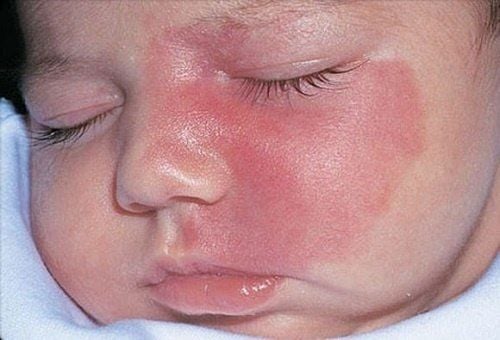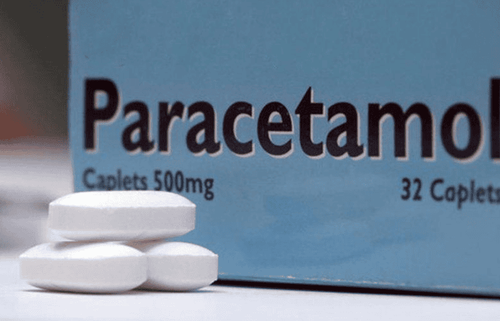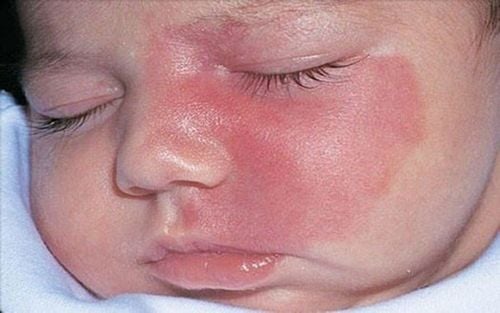This is an automatically translated article.
The article is professionally consulted by Specialist Doctor II Le Thanh Cam - Pediatrician - Pediatrics - Neonatology - Vinmec Danang International General HospitalNeonatal hemangioma is also one of the common diseases in infants and young children. Hemangiomas usually appear in the first years of a child's life as a red, wine-red or strawberry-colored birthmark on the skin.
1. Infantile hemangioma
A hemangioma is a benign congenital tumor formed by the fusion of many overgrown blood vessels, which are not associated with cancer. Hemangiomas usually appear as a bright red nodule that looks like a strawberry. Hemangiomas can appear anywhere in the body, but are most common on the face, scalp, chest, and back.Neonatal hemangiomas usually appear in the weeks following birth and proliferate throughout the first year of life. The development process of hemangiomas includes stages:
Rapid growth stage in the first 2-3 months of life. Regressive development stage (period from 6 to 18 months of age): During this stage, most of the hemangiomas will gradually improve, the hemangiomas will decrease in red and then gradually turn gray, the hemangioblastoma tissue becomes more should be softer, flatter.

Up to now, the cause of hemangioma is still not clear. Some theories suggest that the occurrence of neonatal hemangiomas are related to genetic factors, this risk accounts for 50%, even if the parents have regressed hemangiomas, the child will have the disease. will still be higher than other cases. In addition, hormone problems, immune disorders or abnormalities in blood vessels, the effects of chemicals can also increase the risk of hemangiomas in children.
In fact, clinical classification of hemangiomas is based on the location and mechanism of formation of hemangiomas:
-Based on the mechanism of formation of hemangiomas, they are divided into 2 types: endothelial cell hemangiomas and endothelial cell hemangiomas. vascular malformations.
Endothelial cell hemangioma:
A type of hemangioma that appears at birth, grows rapidly, and is likely to regress when the child reaches the age of 5-7 years. The disease is caused by the proliferation of cells lining the blood vessel wall, the new endothelial cells forming new blood vessel ducts, making the tumor grow faster. The prevalence of the disease in boys is 3-5 times higher than in girls. Vascular malformation:
Is a malformation of the arteries, veins or lymph vessels. The disease mainly develops in adulthood. The disease is caused by endothelial cells that do not proliferate and do not form new blood vessels. The cases of vascular malformations, if not detected and treated in time, can seriously affect the health of children such as ulcers, infections, necrotic areas due to lack of nourishment, heart failure, etc. airway obstruction... -Based on location, divided into 2 types: skin hemangioma and visceral hemangioma.
Skin hemangioma:
An abnormal accumulation of blood vessels above or below the surface of the skin, usually developing during the unborn baby. Location: Face, neck, behind ears. Characterized by raised spots on the skin surface, red like a lipstick mole, the size increases with time and age of the child, sometimes it can develop into a large tumor or a large patch. Common types: Capillary hemangioma, cavernous hemangioma. Hemangioma on the liver:
A hemangioma appearing in and on the surface of the liver. Studies show that hemangiomas on the liver are sensitive to estrogen. Therefore, using oral contraceptives or being pregnant can rapidly increase the size of hemangiomas.

2. Are hemangiomas in children dangerous?
Hemangioma is a benign disease that has little impact on the health of children. Usually, in children with hemangiomas, the disease will progress well, self-resolving when the oldest child is between 5 and 10 years old. However, not all cases go well. In some cases, the tumor continues to grow and proliferate on its own. This can lead to a number of complications such as:Hemangiomas are damaged, ulcerated, bleed or become infected. There is a risk of scarring when the hemangioma is dilated. Hemangiomas affect the functioning of other parts such as hemangiomas close to the eyes, restricting vision, obstructing breathing, reducing hearing, etc. Central neutral system. In essence, hemangiomas are very rarely dangerous to a child's health. However, this does not mean that it is completely impossible, blood tumors can affect the functioning of organ systems when they grow excessively in both shape and size. One thing you can rest assured that hemangioma is not a contagious disease, it is not capable of being transmitted from one organ to another or from one person to another.
Infantile hemangioma is a benign disease, but when the tumor has an excessive proliferation and does not stop growing, it can affect other parts of the body, even causing harm. to the health of the child when the tumor becomes malignant. Therefore, for neonatal hemangiomas, if detected early when the tumor size is small and the blood vessels are also small, the child should be treated immediately to avoid affecting the aesthetics as well as the child's later life. .
As a key area of Vinmec Health system, Pediatrics Department always brings satisfaction to customers and is highly appreciated by industry experts with:
Gathering a team of top doctors and nurses in Pediatrics : consists of leading experts with high professional qualifications (professors, associate professors, doctorates, masters), experienced, worked at major hospitals such as Bach Mai, 108.. Doctors All doctors are well-trained, professional, conscientious, knowledgeable about young psychology. In addition to domestic pediatric specialists, the Department of Pediatrics also has the participation of foreign experts (Japan, Singapore, Australia, USA) who are always pioneers in applying the latest and most effective treatment regimens. . Comprehensive services: In the field of Pediatrics, Vinmec provides a series of continuous medical examination and treatment services from Newborn to Pediatric and Vaccine,... according to international standards to help parents take care of their baby's health from birth to childhood. from birth to adulthood Specialized techniques: Vinmec has successfully deployed many specialized techniques to make the treatment of difficult diseases in Pediatrics more effective: neurosurgery - skull surgery, stem cell transplantation. blood in cancer treatment. Professional care: In addition to understanding children's psychology, Vinmec also pays special attention to the children's play space, helping them to have fun and get used to the hospital's environment, cooperate in treatment, improve the efficiency of medical treatment.
Please dial HOTLINE for more information or register for an appointment HERE. Download MyVinmec app to make appointments faster and to manage your bookings easily.














